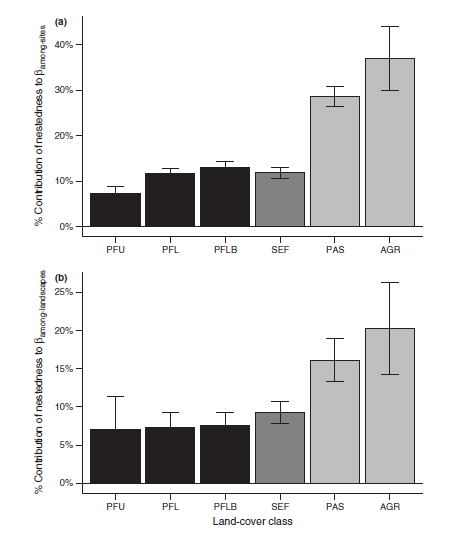“I have been working in human-modified tropical forests for the past 14 years, but seeing these fires first hand was devastating,” wrote Erika responding to one of my questions “The smell of wet soil was gone and I could only smell smoke…even the usual cacophony of forest sounds disappeared…it was like walking through an open cemetery.”
Erika de Berengeur Cesar, an up and coming Brazilian forest researcher, works at Lancaster University. For last two months, she has been slogging away in the field collecting data for her team’s project on human-modified forests. But this year hasn’t gone to plan. This isn’t a case of bad planning though, as with so may projects – 7 of her 20 sites had burned in some of the most widespread fires in recent times. After seeing her tweeting about this, I thought “I need to write something about this. It feels important.” So we fired a few tweets and emails back and forth, with Erika fitting answering my questions between her days in the field. After I had waited impatiently for a couple of days, Erika messaged me:
“Sorry, trying not to work weekends…not going very well though…Today I just learned that 9 of my 20 plots have burned.” 2 more plots. Aside from the wider situation, this was the stuff of researcher’s nightmares.

Fires in Brazil reached record levels in 2015, with more than a quarter of a million separate fires recorded. However, these fires are not generally ‘natural’ – “Fires in the region always have a human ignition source.” Erika told me “They are used in slash-and-burn agriculture, to clear pastures of weeds and also to burn downed timber in newly deforested areas.” This year’s strong El Niño has caused drier conditions than normal making it “easier for agricultural fires to escape the targeted area and sweep through the forests.” Indonesia is facing a similar problem, where forests have been burned to clear space for new oil plantations, in what the Guardian’s George Monbiot has described as the ‘greatest environmental disaster of the 21st century – so far.’
When I queried why it matters that the forest is burning, Erika was clear what the major issue is – the loss of unique biodiversity. “Every year over 100 new species are found in Amazonian forests. To see all this going up in smoke is a crime against humanity. It is a tragedy.”
“How are these fires likely to affect biodiversity?” I asked.
“The Amazon has not co-evolved with periodic fires…This means that Amazonian forests are not used to these events and…do not cope very well with it. In terms of plant communities, there is a sharp increase in the abundance of pioneer species, while high-wood density climax species disappear….Fires negatively affect…rare bird species, and the habitat specialists, such as the ant-following insectivores and the terrestrial gleaners. Overall, burned forests are significantly less diverse than their unburned counterparts.”
Amazonian forests that have burned repeatedly may eventually come to resemble more open savannahs and contain very different species to relatively undisturbed old-growth forest.
But it’s not just biodiversity that is affected by these fires, but humans as well. In Indonesia there were evacuations of children by the navy, although some of the children, according to reports, still died from breathing difficulties . In Brazil the fires have “affected many of the local people…who reported a number of respiratory problems, such as dry cough, difficulties in breathing, and sore throats,” according to Erika. “People had to spend days building fire breaks to protect their land, instead of directly working on their crops.” People working on these farms already have a tough life as it is, without having to worry if their source of income will go up in smoke.
So what will happen to these forests in the future? Given time and, vitally, protection they can recover but Erika thinks this is unlikely “These burned forests may never recover. After the fire, several large trees die, creating a number of gaps in the forest canopy, through which more light and wind can reach the forest floor, making it drier and, as a consequence, more vulnerable to further fire events.”
The research Erika and her team are carrying out will help to answer the question of how burned forests recover but it is obvious that degraded forests, such as these, need to be seen as a greater conservation priority. More than 50% of the globe’s forests are degraded in one way or another. We cannot afford to only protect primary forests anymore.
Edit: I got an email from Erika a bit ago after I asked her what the best solution would be. I thought I should include it here:
“Funnily enough there are already quite a few good policies in place. The problem is that none is followed. For example, every year there is a ‘burning calendar’ establishing when farmers can use fire to burn their pastures or their croplands. During the peak of the dry season, the use of fire is forbidden. In 2015, given the extreme drought, some states even extended the prohibitive period. So all quite reasonable and good, right? The problem is that no one follows this rules and there is no law enforcement in place. So people carry business as usual and the forests carry on burning. To put in practice the existing laws would be the best solution.”
If you want to read more about the situation in Brazil take a look at the excellent article Erika has written for ‘The Conversation.’
There are also a pair of videos that Erika’s team have made documenting the fires that you can see here and here.


